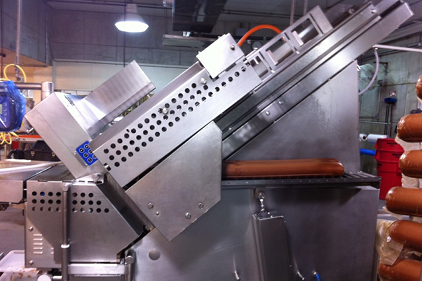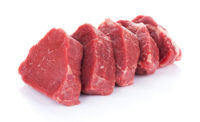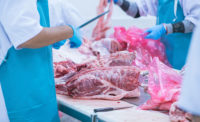Slicing and dicing worker safety


|
Certainly, slicing equipment operators are not strangers to some dicey situations, but even they have their limits. To keep them and other meat plant employees safe, the American Meat Institute recently released a 10-point “Safe Equipment Design Checklist,” with input from equipment manufacturers.
“It’s in our best interest to keep the workforce safe,” says Travis Ellis, AMI worker safety committee chairman and corporate director of environmental, health and safety, at Land O’Frost’s Searcy, Ark., facility. “Manufacturers have complied with everything on our checklist so far, whereas maybe three years ago we would have had to push and push to get these items.”
The voluntary guidelines, while they match 80 percent of Occupational Safety and Health Administration’s (OSHA) current codes, were created to also cover areas specific to the meat industry that haven’t been addressed by government regulations, encompassing equipment guarding, design and engineering, energy control and ergonomics, amongst other criteria.
“From now on, if we purchase new equipment at Land O’Frost, we will say it has to meet the AMI guidelines of providing the newest technology, such as light curtains [the light curtain senses an employee is in a dangerous area and will shut down the machine], low noise levels, limited exposure to chemicals and machine guarding, for example,” says Ellis.
Checking off safety
Proper equipment guarding, for one, such as interlocks at the point of operation, is critical because there can be many ways for an employee to reach an area not intended by the manufacturer, says Ellis.
The AMI guidelines also address how to improve workstation designs so they can better accommodate most workers. One idea is lowering the heights of the machines. Continuous work performed above the shoulder level (or too low) can lead to sprains and strains for employees.
In addition, manufacturers are providing ways to get heavy machine parts in slicers, such as a 90-pound auger, out with ergonomic lift assists so employees don’t have to even break a sweat.
“These parts can now attach to the machine and then slide the auger out that needs to be cleaned, instead of employees moving it themselves and possibly dropping it on their feet,” says Ellis. Log-loading systems are also now automatically moving 30-pound logs off the stuffing machine into racks that are generally six feet off the floor.
“Employees are monitoring the process but aren’t lifting 30 pounds up six feet into racks about 1,000 times a day anymore,” says Ellis.
Other labor intensive jobs are being performed, he says, by vacuum systems that pull product into mixers, and auto peelers that peel casings, so employees have less interaction with the product. Some big plants are even using automatic loading systems and robots.
Most importantly, the general design guideline discusses ways to prevent machines from being turned on accidentally through “lockout/tagout” functions, adding visible isolation devices for lockout/tagout of all energy sources, installing a visible gauge to ensure automatic pneumatic dump valves work properly, and providing on/off controls for testing or checking for power after energy isolation devices have been applied.
|
SIDEBAR |
|
New slicing facility employs latest innovations |
|
Columbus Foods’ new slicing and packaging facility in Hayward, Calif., includes many of the latest innovations and features available to processors today. Deli and salame slicing bats are received in corrugated totes on plastic pallets from Columbus Foods’ two processing plants. The deli slicing bats are stored in a cooler at 28°F for optimum yield, while the salame slicing bats are stored in a cooler at 38°F to 40°F. The deli and salame slicing bats are then sliced and packaged in separate slicing rooms. High-pressure processing (HPP) is utilized for some products to destroy vegetative microbes through ultra-high water pressure without affecting its taste, texture or nutrients. “In addition, a non-turbulent air-filtration system is in both clean rooms, which are standardized, self-sustained clean rooms that minimize the introduction of outside materials and tools,” says Ken Neishi, vice president of operations, Columbus Foods. “The plant has also established hygienic zoning to minimize the micro risk to food and dedicated COP (clean out of place) rooms for each clean room to wash parts and tools.” Some of the features that have been incorporated into the design of the plant and effect ergonomics and employee safety are:
|
Looking for a reprint of this article?
From high-res PDFs to custom plaques, order your copy today!









